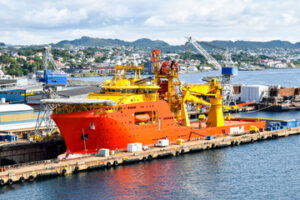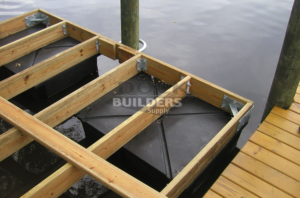All dock components are modular, pre-assembled at the factory, and come with printed assembly instructions, heat-sealed parts packages, and boxed accessories. This makes dock construction a comfortable DIY project.

When you are ready to start putting your dock together, loosen the post clamps and slide the bottom plates on. It’s fine only to loosen the posts so they are at the correct height for now. Click Here to learn more.
Dock installation is a big project that involves heavy equipment, so getting prepared for the process is essential. Depending on where you live, your dock may require a permit or specific guidelines for construction and use. Additionally, you will likely need to have the shoreline cleared of rocks, debris or organic growth in advance of the start of the construction process.
If you’re building a permanent dock, consider using a Perma Anchor system or another permanent underwater anchor. These are easier to install than conventional augers, and they also place the anchor in a way that’s more stable on muddy bottoms. Finally, be sure to choose the right materials for your dock. These will affect everything from the platform’s durability to its ability to withstand weathering and water damage.
Once the foundation is in place, you can begin installing the dock’s frame. This can be done by a variety of methods, including digging a hole and driving in pilings or setting them up on concrete footers (depending on your lake’s depth). For floating docks, using a hose to “jet” the bottom is common.
A good time to prepare the location for your new dock is in the fall before the ice forms, since this will ensure the ground is firm enough to support the structure. It’s also a great time to install a dock ice eater, which will bubble cold water from below the ice to the surface and help keep your dock from sagging in the winter.
As you build the frame, be sure to leave a few inches of space at the bottom of each upright post (unless you’re anchoring on rock). This will make it easier to attach the stringer brackets when you’re ready to put in your decking.
Finally, be sure to use hot-dipped galvanized fasteners during the entire process. Regular, non-coated nails, screws and bolts will rust quickly when exposed to water. Choosing the proper materials for your dock will help it last longer and reduce its maintenance requirements.
Once the frame is built, it’s time to install your dock decking and accessories. This is a critical step in your dock’s performance and safety, so be sure to follow the manufacturer’s instructions carefully. If you’re working on a rocky lake or shoreline, consider adding a few gangplanks to assist with accessing your dock when it’s in use.
Installation
When your dock arrives it will be a complete kit with everything you need to build and install your new boat dock. It’s best to pre-assemble as much of it as possible on dry land before you move it to the water. This will save you a lot of time and effort. It also helps to ensure that all the pieces fit together correctly and that you don’t lose any parts in the water.
Start by removing the pins and fasteners that are attached for shipping purposes from each of the sections. Then, find a clean concrete surface without obstructions where you can lay out each of your dock sections. Begin by looking at the reference medallions on each of the dock sections (the diamond-shaped emblems) to help you determine which way each one should be oriented in relation to the other pieces. This will help you ensure that your dock is level when it’s in the water.
Now that your sections are all positioned you can begin to install your posts. This is a process similar to installing decking. You will need to drill holes in your shoreline and install your footers, then place a treated wood post inside each hole. After you have placed your posts, you can pour concrete around the outer edge of each post and let it set.
Once your posts are installed you will be ready to put in your bottom plates. During this phase you will need to use a carriage bolt and nut to attach each of the bottom plates to each other. After that, you can screw on the black post caps. It’s a good idea to number the bottom plates and their corresponding post so that next year you can remember where each piece goes.
Many communities have laws or regulations that regulate the size, placement and materials of docks on public or private lands. If you’re not sure what your site’s rules and regulations are, it’s important to contact the appropriate authorities before beginning construction. This will save you from having to tear down your new dock later on or face fines for violating the rules.
Maintenance
If you’re planning on using your dock, it’s important to clean it regularly to ensure that it’s safe and free of debris. This process helps to prevent the spread of microorganisms, which can cause serious damage to your dock over time.
When the weather is warm, it’s also a good idea to treat your dock with a preservative or sealant. This will help to keep it looking like new and protect it from fading, cracking, or peeling. Typically, these products can be applied easily with a brush or spray. It’s best to choose a treatment that is environmentally conscious and does not emit poisonous substances into the water, as this poses a threat to marine life.
Inspecting your dock on a regular basis is another important part of maintenance. This allows you to catch any problems before they become larger issues. You should inspect your dock at least twice a year, and particularly after storms or winter seasons, when ice and snow can put extra pressure on the structure. You should check all of the components, including the decking, anchorage system, and coupling system. You should also examine walkways, handrails, and dock equipment.
If you find any problems with your dock, it’s important to repair them right away. This will not only prevent further damage, but it can also make your dock safer for everyone who uses it. If you’re unsure of how to fix something, contact a professional, who will be able to give you advice and recommend the correct repair method.
Many docks, even those made of wood, require regular maintenance to keep them in good condition. It’s important to sand and stain the surface of your dock annually, as well as reapply protective coatings. In addition, you should also lubricate the chains on your dock’s winches and mooring lines to prevent rust. It’s also a good idea to cover your dock in the winter to prevent ice and snow from damaging it.
As an alternative to cleaning and staining, you can also consider painting your dock. This is a cheaper option, and it’s also easy to do. Just be sure to use a high-quality paint, so that your dock will last as long as possible.
Removal
When the season ends, removing your dock can be an arduous and time-consuming task. Whether you are removing your dock to prepare for winter or simply to take down some of the components, there are certain steps that should be taken to ensure a smooth and efficient process.
Before starting the removal process, be sure that you have gathered all necessary tools and equipment. This may include a boat or pontoon, ropes and buoys, as well as a dock removal tool kit. In addition, you will need to disconnect any electrical and water connections. This will help prevent any potential accidents or damage during the process.
It is also important to remove any additional dock accessories, such as benches or boat lifts. This will make the pier lighter and easier to work with. Additionally, if your pier is filled with water above the waterline for stability, it’s a good idea to drain it. This will not only make it easier to remove, but it will also ensure that the pier is not damaged by moisture or pests while in storage.
Another important step is to clear away any debris that has accumulated on the dock over the course of the summer. This will help you to get a better idea of the condition of the dock before and after removal. It is a good idea to take this opportunity to clean the entire dock and make any necessary repairs or replacements.
Taking down your dock can be an overwhelming task, especially if you have a large or complex one. However, by following some simple tips, you can make the process much easier and less stressful.
One of the most important tips is to plan ahead and be organized. This will make the job go a lot more smoothly and will allow you to save time and energy. It is also a good idea to purchase or rent a dock removal tool, which will make the job much easier. This will reduce the likelihood of injuries and will make the process faster and more efficient.
